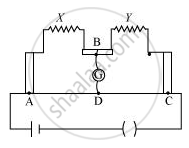Advertisements
Advertisements
प्रश्न

The figure shows experimental set up of a meter bridge. When the two unknown resistances X and Y are inserted, the null point D is obtained 40 cm from the end A. When a resistance of 10 Ω is connected in series with X, the null point shifts by 10 cm. Find the position of the null point when the 10 Ω resistance is instead connected in series with resistance ‘Y’. Determine the values of the resistances X and Y.
उत्तर
For a metre bridge:
`X/Y = l_1/(100 - l_1)`… (1)
Where, it is given that l1 = 40 cm
`X/Y = 40/(100 -40) = 2/3`… (2)
When 10 Ω resistance is added in series to X, null point shifts by 10 cm.
`(X+10)/Y = (40+10)/(100 - (40 +10))`
`X +10 = 50/50`
`(X+10)/Y = 1 or X+10 = Y ..... (3)`
Substituting the value of X from equation (2), we obtain
`2/3y+10 = Y`
`10 = Y -2/3 Y`
or
`Y/3 =10`
`Y =30 Omega`
Substituting the value of Y in equation (3), we obtain
X + 10 = 30
X = 20 Ω
Position of the null point when 10 Ω resistance is put in series with Y,
`20/(30+10) = l_i/(100 - l_i)`
`2000 - 20l_1 = 40l_1`
`60l_1 = 2000`
`l_1 = 2000/60`
`l_1 = 33.3 cm`
APPEARS IN
संबंधित प्रश्न
The instrument which can measure terminal potential difference as well as electromotive force (e.m. f.) is ______
- Wheatstone’s meter bridge
- Voltmeter
- Potentiometer
- Galvanometer
State any ‘two’ possible sources of errors in meter-bridge experiment. How can they be minimised?
A potentiometer wire has a length of 4 m and a resistance of 5 Ω. What resistance should be connected in series with a potentiometer wire and a cell of e.m.f. 2 V having internal resistance 1 Ω to get a potential gradient of 10-3 V/cm ?
Why is it generally preferred to obtain the balance point in the middle of the meter bridge wire?
When a resistance of 12 ohm is connected across a cell, its terminal potential difference is balanced by 120 cm length of potentiometer wire. When the resistance of 18 ohm is connected across the same cell, the balancing length is 150 cm. Find the balancing length when the cell is in open circuit. Also calculate the internal resistance of the cell.
Write the principle of working of a metre bridge
In a metre bridge, the balance point is found at a distance l1 with resistances R and S as shown in the figure.An unknown resistance X is now connected in parallel to the resistance S and the balance point is found at a distance l2. Obtain a formula for X in terms of l1, l2 and S.

An I0m long uniform metallic wire having a resistance of 20Ω IS used as a potentiometer wire. This wire is connected in series with another resistance of 480Ω
and a battery of emf 5V having negligible internal resistance. If an unknown emf e is balanced across 6m of the potentiometer wire, calculate
1) the potential gradient across the potentiometer wire
2) the value of the unknown emf e.
In a meter bridge experiment, resistance are connected as shown in figure, The balancing length 1, is 55 cm. Now an unknown resistance x is connected in series with P and new balancing length is found to be 75cm. The value of x is ______.

In a sensitive meter bridge apparatus the bridge wire should possess ______.
